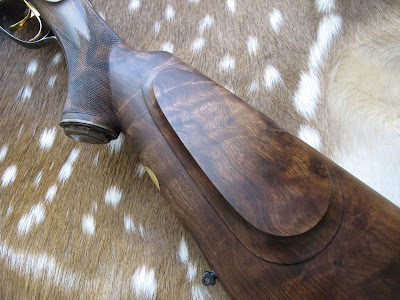 |
| The Winner-Dan Larsson of St. Ignatius MT |
The 6th annual Safari Rifle Challenge is in the books. Here
is a recap of this year’s event made by Jay Sheffield. Jay is the Match
Director of the Safari Rifle Challenge World Championships:
The 75 participants enjoyed a sunny 70 degree Montana day
and when the dust settled, Dan Larsson of St. Ignatius MT was the winner.
Shooting a .375H&H he scored 197 out of a possible 200! A huge thank you to
Shawn Joyce of Diizche Safari Adventures who has become our main sponsor. A big
thanks also to Jeff Sipe and Dave Wisher of Montana Rifle Company and Andy
Larsson of Skinner Sights. Without the support of these men, we would not be
able to put on the quality of shoot that we now offer.
For those who are interested, here is the 2016 course of
fire........
2016 Safari Rifle Challenge Course of Fire. Your rifle
MUST remain in the rack unloaded with the action open at all times. Do not
handle rifles unless you are specifically directed to do so by a range officer.
This is a fun shoot designed to test your skills but safety is paramount.
Unsafe gun handling will not be tolerated and violators will be asked to leave
the range immediately. The range officers are here for everyone’s protection
and their directions are law! The RO’s will call and record your score. Please
check your score sheet immediately because no scoring errors may be challenged
after you leave the firing line.
1. Checking Zero ---- Four shooters on the line. Starting
position will be EMPTY rifle, safety off, shouldered and pointed at the target.
On the whistle you will load and fire one round then load and fire a second
round. Open action, show clear, muzzle up during scoring and return to the gun
racks.
2. Shooting Gallery --- Shooter will place unloaded rifle
and three rounds on the table. Shooter will take a one gallon jug and hang it
on the hook. On the command shooter will give the jug a good push then run back
to the table, load rifle and shoot at the jug until it bursts. If you have any
rounds left then shoot the hanging 5” DuraSeal ball. Open action, show clear,
muzzle up when done.
3. Charging Lion --- Rifle loaded with two rounds, safety
on. On start command, lion will head towards you. You must then kneel down on
one (or both) knees, disengage safety and fire both rounds. Open action and
show clear before getting up.
4. Fast Blast --- Two shooters on the line. Two rounds in
rifle, safety on. On the command shoot the two jugs in front of you. If you
burst both jugs then you may load a third round and shoot the gong. First
person to hit gong gets an extra 10 points. Open action, show clear, muzzle up
when done.
5. Two Elephants --- Rifle loaded with one round, safety
on. Fire at the close elephant target. Move to the next spot, load one round
and fire at distant elephant. Open action, show clear, muzzle up when done.
6. Rhino and Hippo --- Rifle loaded with one round,
safety on. Fire at hippo target. Move to the next spot, load one round and fire
at rhino target. Open action, show clear, muzzle up when done. (Kill zones will
be faintly marked for scoring purposes; you must evaluate the angle then shoot
at the heart/lung zone just like in real life).
7. Fleeing Buffalo --- Rifle loaded with two rounds,
safety on. On the signal the buffalo will start going away. You must FIRST
shoot at the 10” 50 yard gong. Your SECOND shot will then be at the buffalo.
Open action, show clear, muzzle up when done.
8. DuraSeal Challenge --- Two shooters on the line. Two
rounds in rifle, safety on. On the command, shoot the two 5” DuraSeal targets
in front of you. If you hit them both then load a third round and be the first
one to hit the gong. First person to hit gong gets an extra 10 points. Open
action, show clear, muzzle up when done.
9. Charging Water Jugs --- Two shooters, two rounds in
rifle, safety on. The cart will start towards you and you will then be given
the shoot command. You must shoot the jug on your side then race to shoot the
middle jug. Open action, show clear, muzzle up when done.
10. Long Range Gong --- One shooter, one round in rifle
with safety on. On command, take one standing offhand shot at the long range
gong. Closest gong is for open sights; farthest gong is for optical/dot sights.
Open action, show clear, muzzle up when done.
Below are pictures of a few of the
stages (click to enlarge images):
Next year, the 2017 Safari Rifle Challenge World Championships will again be held in Libby, Montana at the Libby Rod and Gun Club. The event is always held on the second Sunday in July. There is a large community fund raising concert every year on the second Saturday so they piggy-back with that to give shooters something else to enjoy while they are visiting Libby, Montana. Jay Sheffield puts on an exciting and enjoyable event.
We hope to see you next year!



























































